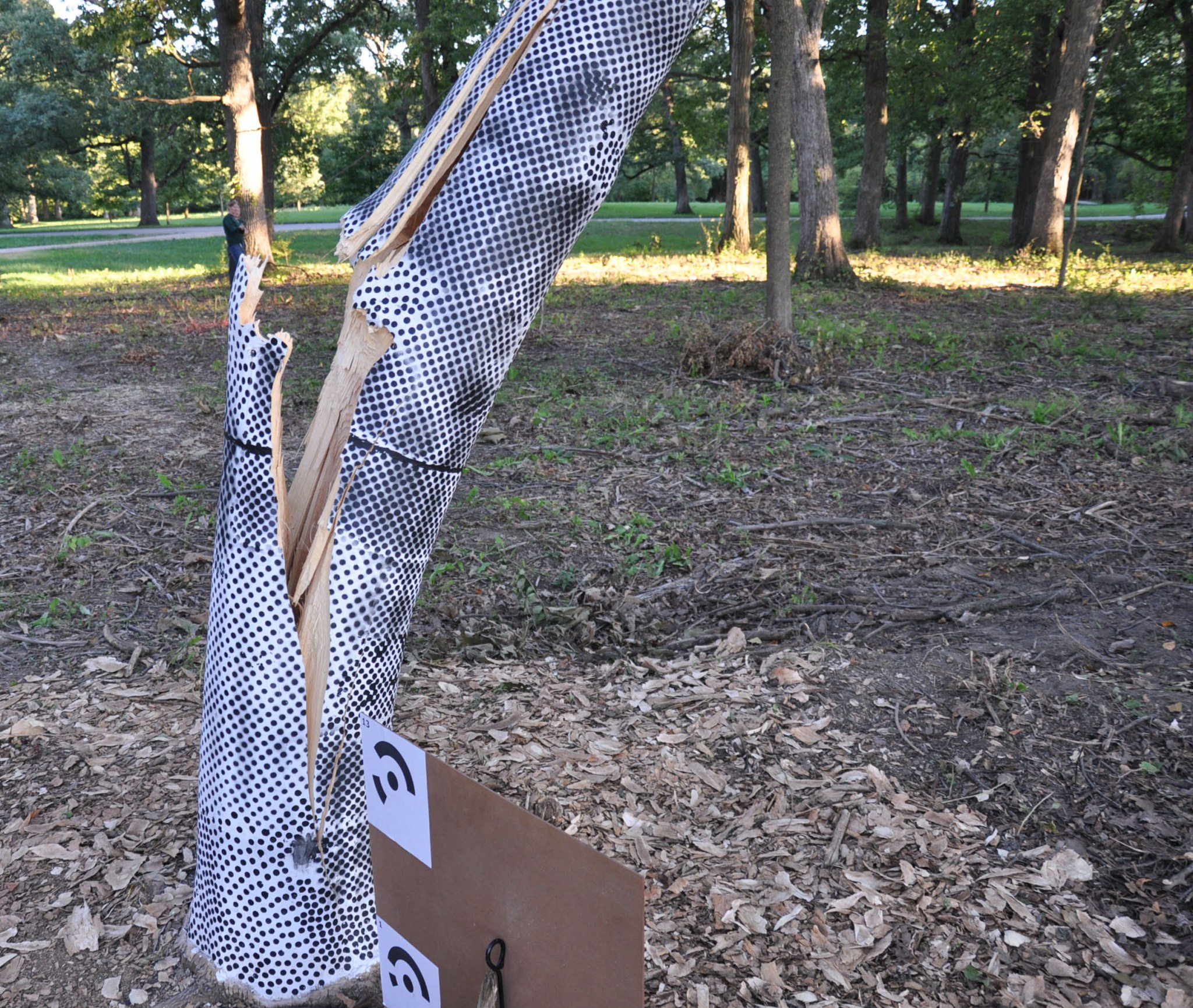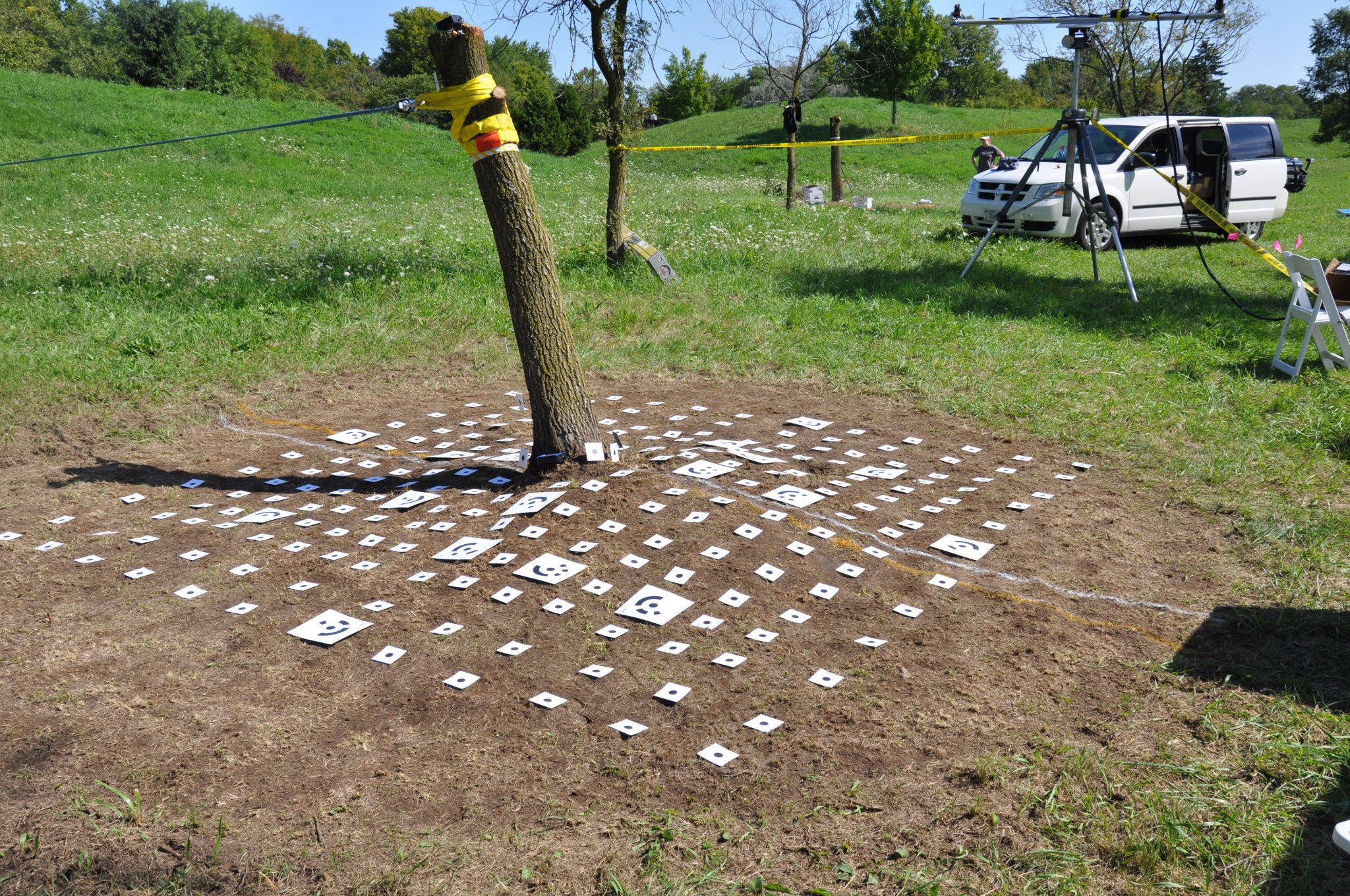It all started when two trees began to die in Matt Melis’s front yard. When the NASA Glenn engineer noticed the robust health of a mighty oak tree in his neighbor’s front yard, he asked for advice and was referred to local Cleveland arborist Mark Hoenigman. They’ve been working together to save Matt’s trees ever since.
Hoenigman was servicing Melis’s trees one day when he mentioned that he and the greater arboriculture technical community were struggling to find better ways to quantify and understand the biomechanics of tree failure. They wanted to know how trees fail under hurricanes, ice and snow loads, but attempts at finding a comprehensive way to measure and analyze the data weren’t adequate. NASA Glenn Engineer Matt Melis looks at data being generated by stereo photogrammetry equipment during tree biometrics research.
Tree failure has caused billions of dollars in damage to buildings and the infrastructure of utilities. Understanding how trees fail under the strains of extreme weather is critical for arborists as they work with businesses to find solutions to reduce damage. This includes learning to properly prune trees, without destroying their vitality, to resist loads from snow and wind.
Melis had just the answer-stereo photogrammetry-technology he used during the Space Shuttle Columbia accident investigation. “Stereo photogrammetry is the science of analyzing sets of stereo images with computer software to accurately calculate full-field 3-D deformation and strains in the structures we test,” explains Melis. “NASA Glenn is the biggest user of this technology in the agency. We use it for measuring structural response on a great many things we test in our day-to-day work. The technique is used on anything from full component testing down to a fundamental materials sample test.”
But how would this technology be used to capture the deformation of full-grown trees? Melis told Hoenigman that he only needed a can of white paint and a can of black. Black and white dot patterns are painted on the test articles to enable the software to better track the structural motion. Research trees were whitewashed and black dots were applied so computer-imaging equipment could capture the stress points as the tree was pulled by a winch.
One day Melis and some of his co-workers conducted a demonstration to a nationwide group of foresters and arborists to show how the technique could be used to measure deformations in the root, trunk, branch and canopy elements of a tree. For example, photogrammetry captured all the data when branches were pulled until they broke and the tree was shaken to see how the canopy swayed back and forth as if in a windstorm.
The demonstration was a technical first in tree biomechanics and it would open up a new horizon for this scientific community.
The project worked so well that last year, researchers at the Morton Arboretum near Chicago proposed a grant to the Tree Fund, an organization devoted to funding tree research and education in arboriculture and urban forestry. The Tree Fund awarded the grant to Morton, which was used to fund a Space Act Agreement to bring Melis and NASA Langley engineer Justin Littell to the arboretum to conduct a week-long collaborative photogrammetry research study at their research tree farm. The effort would focus on capturing deformation and strains in tree trunks and root structures.
“Part of the experiment was showing we could generate consistent data,” says Melis. To prepare the trees for testing, the bark was stripped off and whitewashed up to 12 feet. Black dots were then painted on the white trunks, which enables computer software to accurately track the deformation of the trees as they were slowly pulled from the top with a winch.
As Morton continues to analyze their data, one thing was clear early in the experiments. Knots and malformations in the trunk represented weak points that tended to fail more frequently.
An additional set of experiments was conducted examining the root structure deformation of the trees. “We plotted out a 12′ x 12′ section of ground surrounding the tree and placed dozens of dots on the ground,” says Melis. “Then we pulled the tree down and measured the deformation of the ground and root plate to a high degree of accuracy.”A dot pattern was plotted to measure deformation of the ground when the root plate of the tree was put under high stress.
NASA Glenn’s success at Morton has gained more attention from the biomechanics community. A consulting firm, Bio-Compliance, is working with utility companies on the east coast where billions of dollars have been lost due to extreme weather events including Hurricane Sandy. The company wants Melis and his team to look at branch structures. Falling branches account for a high degree of damage to property and have been responsible for human fatalities during these incidents.
“Our work on these projects is an example of how NASA can make a difference in advancing the science of the environment by spinning off capabilities used in its day-to-day operations,” concludes Melis. “We now have demonstrated stereo imaging to be a valuable tool which can lead to greater understanding of tree biomechanics, creating safer communities and infrastructure during extreme weather.”


























